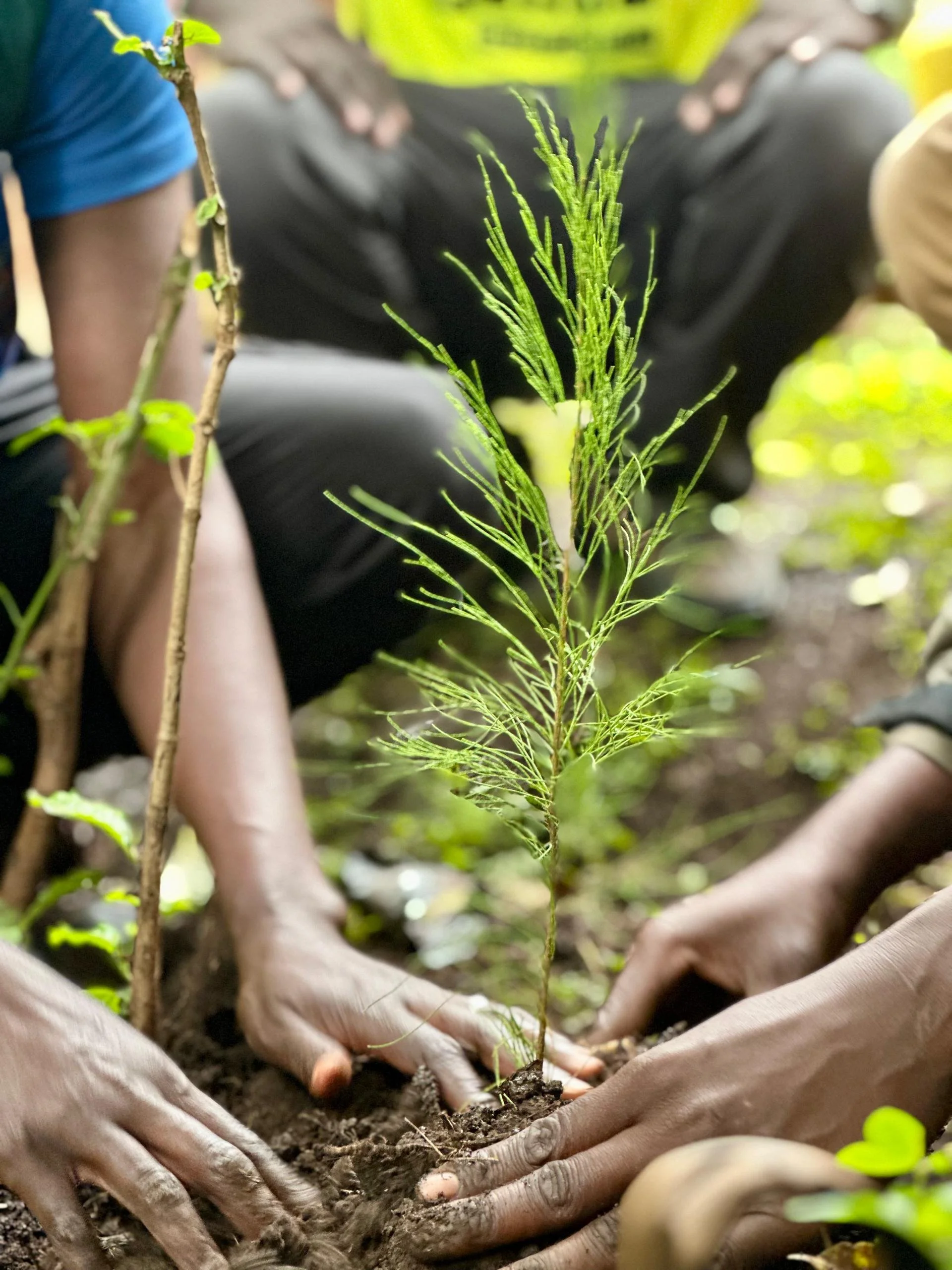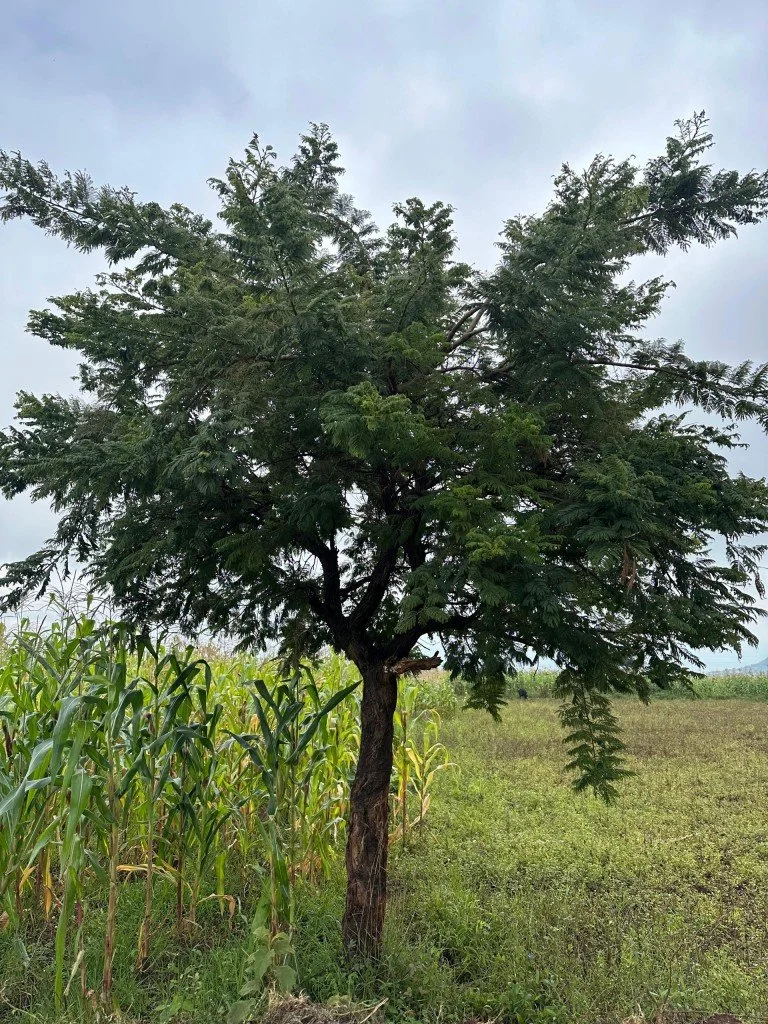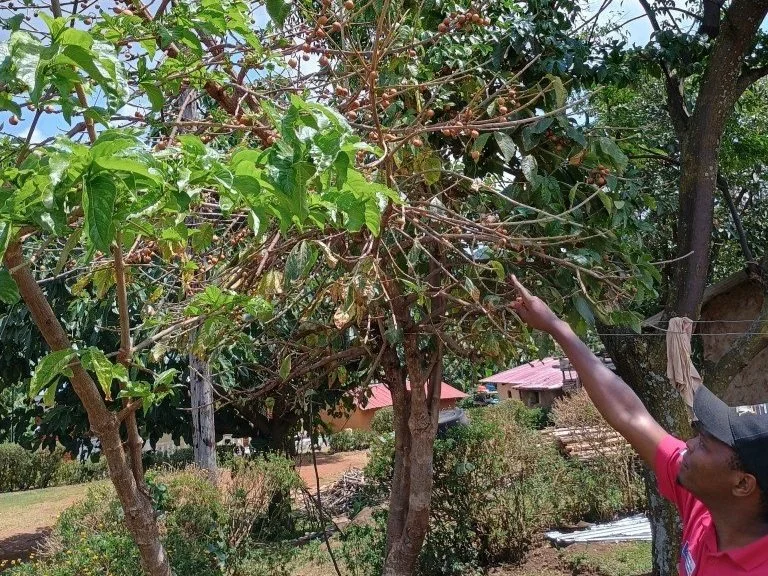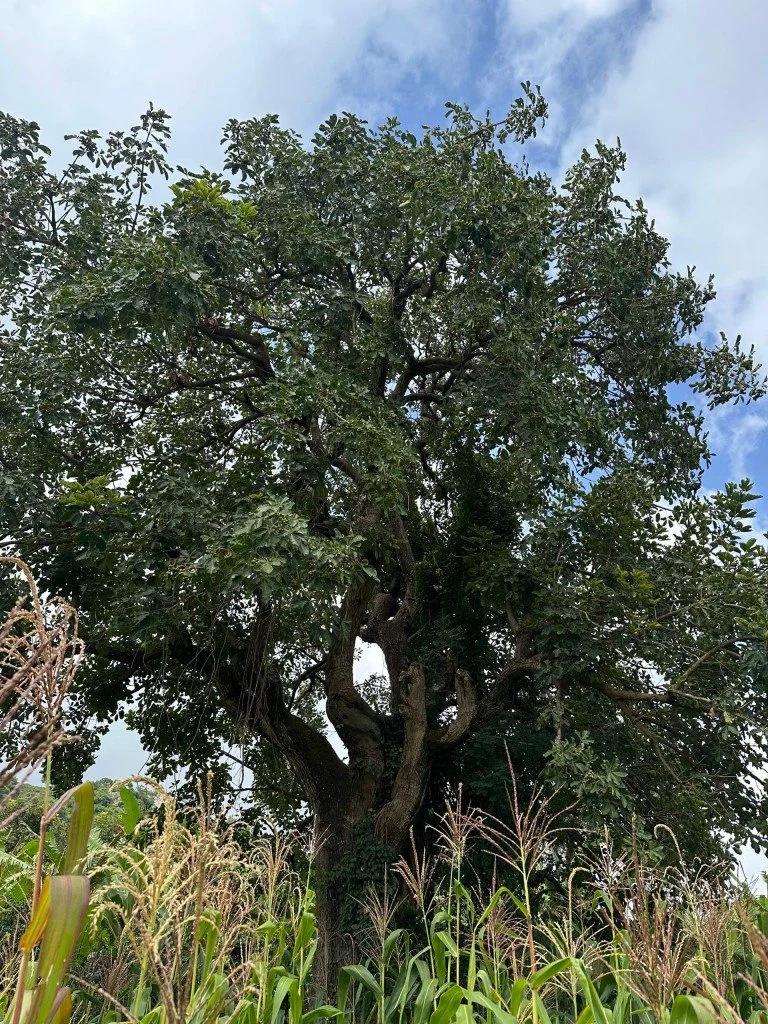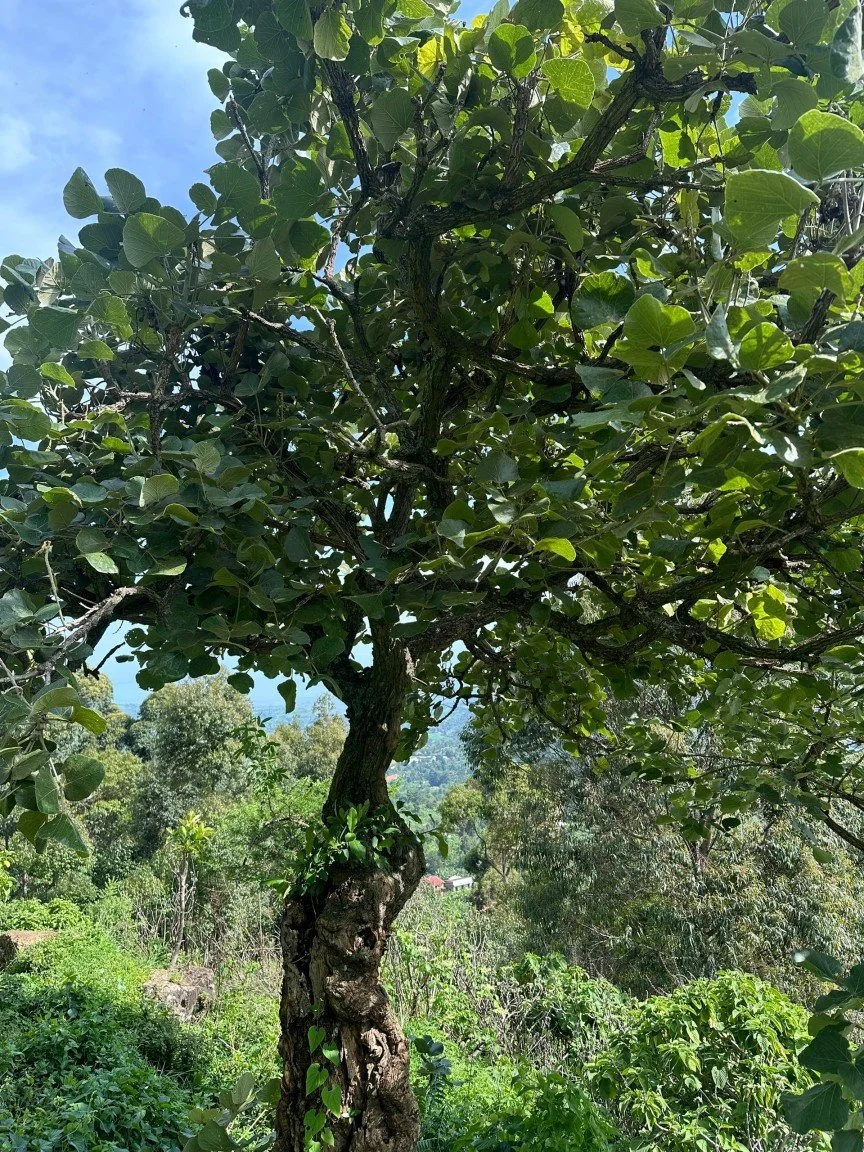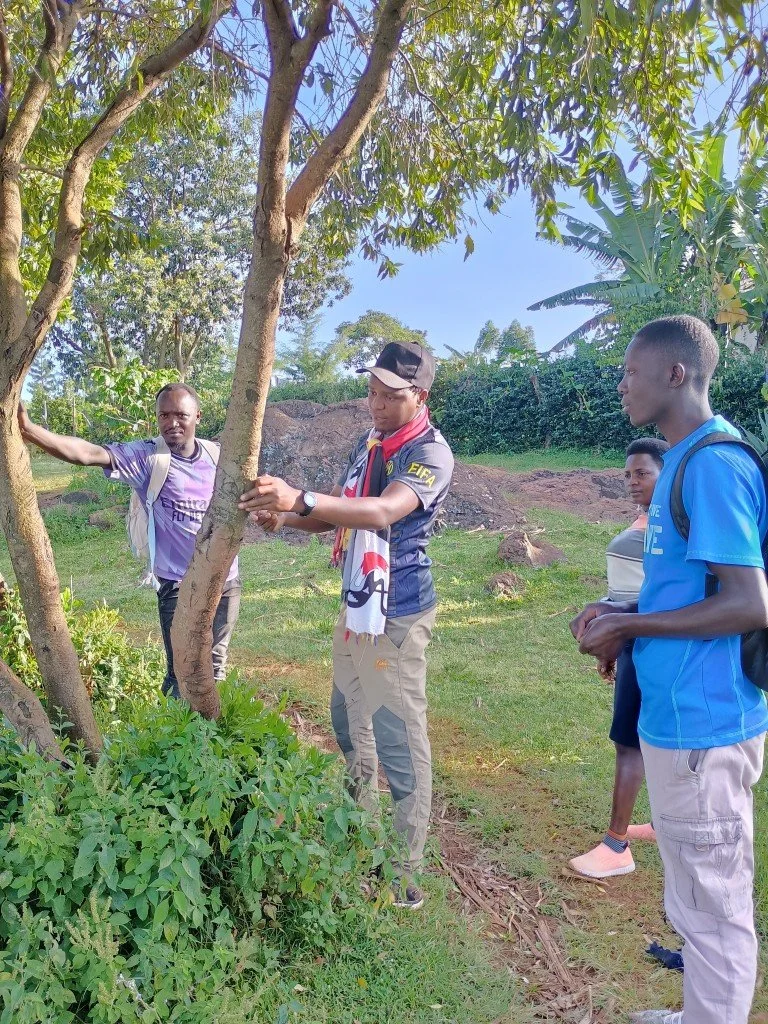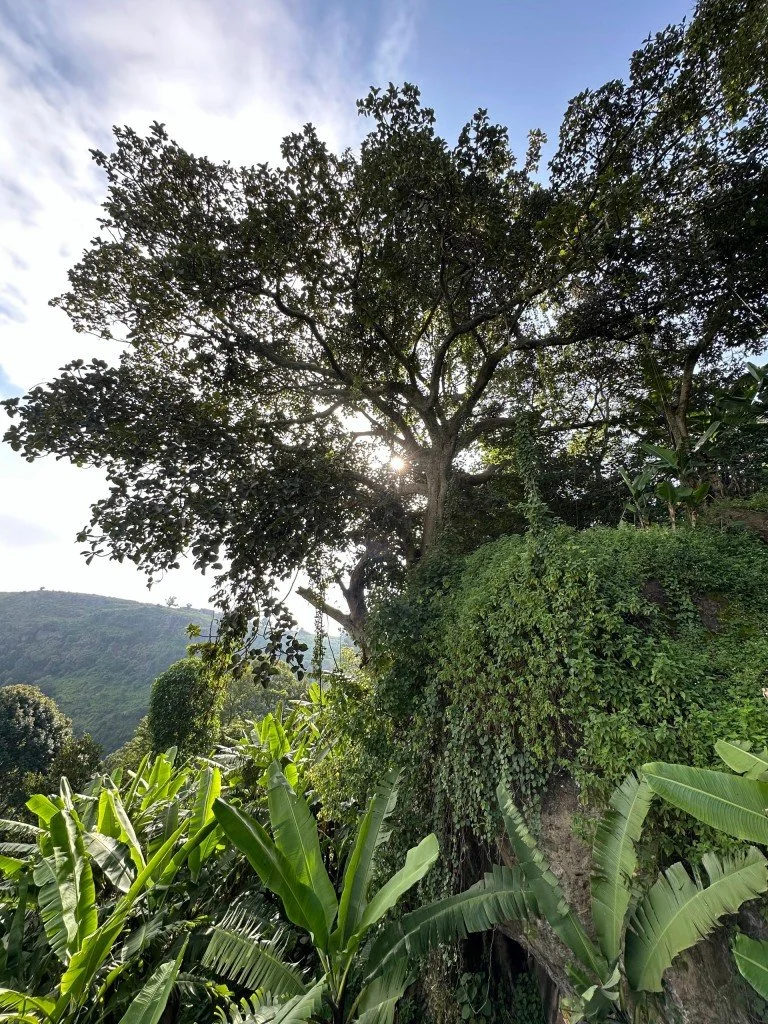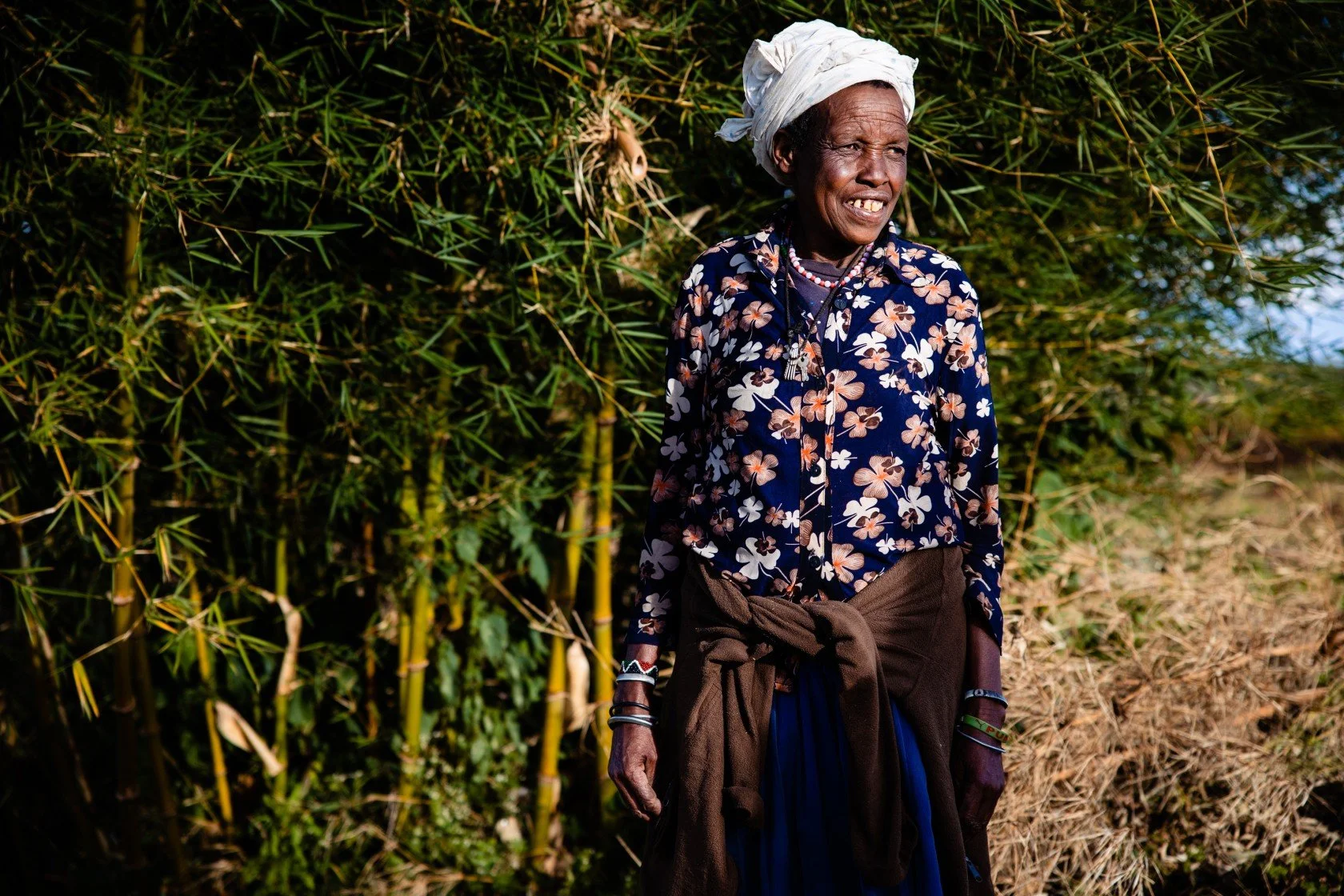In Kapchorwa, trees are more than just part of the landscape. They’re sources of medicine, ancient traditions and practical wisdom. Under its shades, generations have passed down knowledge, shaping a way of life where people and nature are deeply connected.
Together with Shadrack, a native storyteller and seasoned hiking guide, I have explored and mapped Kapchorwa’s most remarkable indigenous trees.
Join us as we uncover their fascinating and fun stories.
Why indigenous trees matter
Kapchorwa’s indigenous trees are not just beautiful. They are an essential part of life on the slopes of Mount Elgon. Their roots grip the steep slopes, stopping soil from washing away. Their branches shelter birds, insects and animals. And their broad canopies soften the equatorial sun, making life in the dry season (= November to March) a little easier. Without the indigenous trees, the lush green scenery that Kapchorwa is known for would quickly disappear.
Cultural, spiritual and medicinal value
For the Sebei and Mosopisiek people, some trees are seen as homes for ancestral spirits. Others are central to Community rituals or valued for their healing properties. Kapchorwa’s indigenous trees are woven into the daily life and culture, even in today’s modern society.
Take the Mowet tree for example. Kapchorwa’s Kapchemweny clan believes their ancestral spirits dwell around this tree. To the rest of the Sebei Community the tree has a cultural significance which prohibits them from cutting it. This is good news for the region’s Arabica coffee as the Mowet tree gives it a pleasant shade:
A Mowet tree in Siron village, one of our first discoveries along the Kapchorwa Wilderness Hike exploration (October 2024)
Sustainability challenges
Kapchorwa’s indigenous trees are under threat. Deforestation and modern development are threatening these natural giants. But many Kapchorwa people are doing something about it. They’re planting seedlings, raising awareness and fighting to protect what’s left…
A tree being planted together with hiking guests (2025). Photo credit: Shadrack Chebet
Meet the Trees of Kapchorwa
Time to meet the indigenous trees of Kapchorwa! From the lower slopes (1300–2000m ASL) to the higher altitudes (above 2000m ASL), each tree has its own story.
In the lower belts, trees grow slowly and stay small, but their fruits are both tasty and useful. Higher up, the trees shoot skyward, offering softwood for practical use. Across the region, locals rely on bark, leaves, roots & fruits for medicine, ceremonies and daily needs like firewood and tools.
Many indigenous tree names in the local Kupsapiiny language end with “wet” or “weet.”
Ready to discover what makes them so special? Here we go:
Kakorweet
This tree carries deep cultural significance. It’s used in ceremonies when a clan needs to split, something that happens when the clan becomes too large to arrange marriages within its boundaries (marrying someone from your own clan is strictly forbidden). Due to its important role in these traditions, it’s considered taboo for women to use Kakorweet as firewood.
One of our native guides explained to us that when she was young, and her or her friends had mumps, they would run around this Kakorweet tree and sing a song to encourage the mumps to move to the tree.
Mowet
Regarded as the home of ancestral spirits, thankfully the good ones, Mowet trees are both sacred and majestic. These trees can grow to an impressive size, like the giant one at Masha Coffee in Bininyi, which was even used in their logo. There’s another massive Mowet tree, said to be over 200 years old, in the Kapchemweny clan of Uganda’s Minister of Water and Environment, Mr. Cheptoris.
Mowet trees like to grow on rocks with holes that can harbor snakes. Although on site the snakes may look scary, they are not a real threat to the Community. Therefore the snakes are referred to as ‘Kuko’, meaning grandfather.
A Mowet tree at the compound of Masha Coffee in Binyiny, Kween District (2025)
Nugugut
Deep within Mount Elgon National Park grows the Nugugut tree, which is deeply respected by the people of Kapchorwa and their Kalenjin relatives in Kenya. This tree plays a central role in traditional circumcision rituals for boys, typically held every even year. However, if the Nugugut tree happens to flower that year, the ceremonies are postponed, as the omen is believed to bring disaster.
Because of the significance of circumcision, the Nugugut tree marks important moments in the Community’s history. When it flowered in 1902, it was seen as a sign of caution for the Sowe/Kapchemutwo age set, who were due for their traditional circumcision rites. However, they proceeded despite the warning, leading to unexplained misfortunes.
In 2016, the Nugugut tree blossomed once again, but this time, the Community chose to respect its message. They postponed the initiation ceremonies to 2018, ensuring that traditions were honored in harmony with nature’s signs.
Mutoomut
Found in the upper belts, the Mutoomut tree is easily recognized by its striking white flowers that grow straight out of the trunk after the mixture of leaves & flowers fade off. It’s a unique, leafless wonder. Traditionally, this tree is believed to chase away bad spirits. Elders perform small rituals using Mutoomut to cleanse an area or a household. Even today, many natives like to plant this tree in their compounds for beauty and protection!
Keresyoondet
The name Keresyoondeet is tied to sacrifice. In traditional ceremonies this tree plays a critical role in appeasing the elements. During prolonged droughts, plagues or other persistent disasters, elders sacrifice a goat or sheep, burning it with the wood of the Keresyoondeet tree to bring rain or relief. This sacred tree is predominantly found in the upper belts of Kapchorwa.
In Kapkoros, Bukwo District, there is a site where the natives used to perform joint sacrifices. The Keresyoondeet tree is also commonly known as a strong firewood.
Kombolyet
This tree starts off as a humble shrub before growing into a sturdy tree. But long before it reaches its full height, the Kombolyet tree serves a special purpose: walking sticks. These aren’t just for the elderly or those with mobility issues. In local tradition, every man carries a stick as a sign of identity.
A young, unmarried man carries a simple, straight stick. But once he marries, he receives a new one. This time with a small branch, symbolizing his new status. If he takes a second wife he gains another branch on the opposite side. More than just a walking aid, the Kombolyet stick is a living record of a man’s journey through life.
Juniet
The Juniet is known locally as kateet and internationally as acacia. It is a thorny tree that grows tall and strong, but its role in tradition is even more striking. Near Kapkwata in Kween District, an entire village is named after this tree.
Historically, its sharp thorns were used in an age-old practice to "straighten" young men. A thorn was carefully pricked through the skin beneath the penis, and a single hair from a cow’s tail was tied through it. After two days, the hair was removed, marking a step in a young man's path to manhood.
Majestic Juniet trees standing tall on a Kapchorwa cliff. Photo by Shadrack Chebet (2025)
Mukuukwet (Chemaganynanyeet)
This tree flourishes in the lower belts and plays a sacred role in child naming ceremonies. According to tradition, elders gather at a homestead to perform incantations throughout the night. If the ancestral spirits approve a chosen name, they cause the tree’s fruit to miraculously balance on a small stick planted in the ground.
Msheembuut
Highly respected among the natives, the Msheembuut tree was traditionally used to mark land boundaries. Unlike today’s fencing or milestones, which often lead to disputes, this tree carried a powerful warning. It was believed that anyone who uprooted it to cheat their neighbor would be cursed with bad luck.
Msheembut tree in one of the villages near Kapchorwa Town. Photo credit: Shadrack Chebet (2025)
Soshondeet (palm tree)
Growing along riverbanks, the Soshondeet palm tree is treasured for its unique uses. Its branches and leaves are crafted into tools for cleaning the gourds that store sour milk (called ‘kwerionek’ in Kusapiiny), an essential and prized nutritious drink in the region.
ℹ️ The Soshondeet tree also has spiritual significance. The clan of Shadrack’s mother, known as Kap Sosho (meaning "home of palm trees"), is part of the current royal family of Sebei. During Palm Sunday, locals cut palm branches and place them in their homes, believing they bring blessings and good luck. A year later, they replace them with fresh ones, continuing this cycle of faith and tradition.
Tobongweet (Caracas big-leaf)
Tobongweet starts as a plant but eventually grows into a tree. The village of Kaptobomwo (meaning "home of the Tobongweet plant"), neighboring Home of Friends Guesthouse, is named after it.
This tree plays a key role in farming. It blooms just before the rainy season, indicating to farmers that it’s time to plant. If rain falls before the tree has flowered, locals know it’s a “false rain”, a short-lived downpour comes in that won’t sustain crops. This natural weather forecasting has guided generations of farmers through unpredictable seasons.
ℹ️ In the old days, it used to also be the Sebei prophet who would predict when rain or natural disasters would be on the way. Read more about the role of prophets in our dedicated culture blog!
Rotyandeet (Sausage Tree – Kigelia Africana)
Mostly found along riverbanks in the lower belts, this tree produces large, sausage-shaped fruits. When dried, the fruit is transformed into a natural bathing sponge. Nowadays, these sponges are sold in supermarkets, known for their texture and ability to scrub off dirt after a long day's work.
Medicinal trees
In Mount Elgon’s lush landscapes, trees are nature’s all-in-one pharmacy and supermarket. Some fruits are loved by people, others by birds and monkeys. The elders often remind us that these fruits don’t just satisfy hunger, they can actually prevent and cure diseases.
Its the highest time to present to you some of the most significant medicinal trees:
Kumolweet
This hardy little tree is a survivor, thriving in both the upper and lower belts of Mount Elgon. It doesn’t grow very tall but produces plenty of healthy fruits, especially in the warmer lower regions. Known for its resilience and abundance, Kumolweet is a favorite for anyone seeking a reliable source of nutritious fruit.
Shadrack showcasing a Kumolweet tree close to our Guesthouse (January 2025)
Laketetweet
Found in the lower belts, Laketetweet is celebrated for its medicinal powers. It is a natural remedy for multiple ailments, from high blood pressure to stomach upsets.
Lakatetweet tree. Photo credit: Shadrack Chebet (2025)
Kamiryondeet
The Kamiryondeet tree is beloved by adventurous young boys, who love climbing its sturdy branches to gather its round fruits. These fruits are not only popular in local neighborhoods but also find their way into the supermarkets of Kapchorwa Town, making this tree to contribute to both fun and the local economy.
Kamiryondeet tree near Kapchorwa Town. Photo credit: Shadrack Chebet (2025)
Tagamamyandet
This tree is a staple in the cooler upper belts, producing berries in two distinct varieties: exotic and indigenous. The indigenous variety, with its smaller berries and leaves, holds a special place in local traditions and diets, making Tagamamyandet a symbol of the region’s natural diversity.
The Tagamanyandet fruit tree in the Community of Barawa next to our Guesthouse. Photo credit: Shadrack Chebet (2025)
Kabatara
A favorite among birds and monkeys, the Kabatara tree adds a lively touch to the ecosystem. Its fruits are also eaten by people and play a vital role in supporting wildlife, ensuring the circle of life thrives in the forests around Mount Elgon.
Aryoweet (Tamarind)
Imagine we are in a season with bad harvests. Instead of having a tasteless breakfast, due to a lack of sugar, we add aryoweet to our porridge. Then for our lunch with posho, we use aryoweet as a sauce. In the evening, when we feel thirsty, we make juice out of aryoweet. In case people have to move out the whole day for grazing, they will find aryoweet in the wild to keep them going!
Kakoorwet
The bark of the Kakoorwet tree is renowned for its wide range of medicinal uses. From soothing babies’ stomach issues to addressing infertility in women, this tree has long been a cornerstone of traditional healing, embodying the deep connection between people and nature.
Kakorweet tree on a Kapchorwa cliff. Photo credit: Shadrack Chebet (2025)
Wusweet
The Wusweet tree is nature’s multitasker. Its branches are used as natural toothbrushes, a testament to its practical benefits. Meanwhile, its bark is a trusted remedy for a variety of illnesses, proving that this tree is as versatile as it is essential to the Community.
The Wusweet tree in the Community of Siron near Kapchorwa Town (2024)
Mokoiweet
The Mokoiweet tree thrives along Kapchorwa’s riverbanks, including the Kaptokwoi River, which eventually joins the Atar River. Its fruits provide a rich source of nourishment for birds and some other animals. But beyond its ecological role, the Mokoiweet features in storytelling and proverbs, symbolizing the natural cycles of productivity. It also serves as a lesson in strategic planning, reminding people to think ahead and time their efforts wisely.
Mokoiweet along the Kapchorwa Wilderness Hike on the lower side of Kapchorwa. Photo credit: Shadrack Chebet (2025)
Plkelweet
This tree, found along the lower belt, produces highly nutritious fruits enjoyed by locals. It serves as a valuable food source and is part of the region’s natural heritage.
Tekyandeet (Bamboo)
Bamboo thrives in the upper belts of Kapchorwa and deep within the Elgon Forest. Its young sprouts are a nutritious food source, often cooked as part of a meal. Once matured, bamboo becomes incredibly versatile. Natives craft it into baskets, granaries, and blending sticks, making it an essential part of daily life.
Mama Chemusto, one of our committed bamboo growers and basket makers along the Mosopisiek Trail in Kween District. Photo taken by Giorgios Voursoukis (2023)
How can you help protect Kapchorwa’s trees
Kapchorwa’s indigenous trees are the lungs of Kapchorwa’s landscape, the home of countless birds, and a big part of what makes this region so special. But with severe deforestation and land clearing over the past decades, these trees need all the help they can get. The good news? You don’t have to be a conservation expert to make a difference. Here’s how you can help:
1. Travel responsibly
Whether you’re hiking through Sipi Falls, exploring Kapchorwa’s off-beaten trails, or enjoying a coffee tour in the Community of Kween, small choices can have a big impact:
Walk on clear trails to avoid trampling young trees or fragile roots.
Resist the urge to collect plants or seeds.
Say no to unnecessary tree-cutting, whether it’s for firewood or souvenirs.
2. Plant a tree (or two!)
At Home of Friends, we believe in giving back to nature. That’s why we’re working on a tree-planting initiative, where guests can get their hands in the soil and leave an impact. We plant indigenous that match the particular trail and altitude. Want to get involved? Just ask or read on to learn about the top-3 indigenous trees for two of our hiking trails.
3. Spread the Word
Every conversation about conservation matters. Share what you’ve learned about Kapchorwa’s trees, post your experiences and encourage others to travel responsibly. Sometimes, a simple conversation can inspire someone else to take action.
Let’s keep our indigenous trees thriving together!
Hiking with a Purpose: Plant a Tree on Our Trails
Hiking in Kapchorwa is already an unforgettable experience. Abundantly green nature, panoramic views and the occasional encounter with a champion runner out for a morning jog. But what if you could leave a positive impact on the landscape?
We’re introducing a new way to connect with nature: tree planting along our hiking trails. Each trail has been matched with three indigenous trees that thrive in that specific environment and support soil health for native farmers and families:
Kapchorwa Nature Walk: Trees That Strengthen the Land
This trail takes you through beautiful farmland, past small streams and over a rocky escarpment with amazing views. The trees we plant here help prevent soil erosion, improve biodiversity and provide natural shade for coffee and banana plantations.
Here’s our top-3 indigenous trees for the Kapchorwa Nature Walk:
1) The Mukengeret tree, also known as Cordia Sebestena, is an indigenous tree meant for quality production of timber and furniture. The tree takes long to mature. But here is one the Mukungeret’s that has reached an older age:
2) The Yellow Trumpet Bush, locally known as the Swayet tree, is commonly known for its yellow flowers and good quality timber products.
3) The Ficus SPP is the most common type of indigenous tree in Kapchorwa. The seedlings are dispersed by wind.
Kapchorwa Wilderness Hike: Trees That Restore the Wild
For those who love a rugged adventure, this trail offers deep forest, remote hills and a taste of true wilderness. Here, we plant trees that ensure the area remains wild and beautiful.
Here’s our top-3 indigenous trees for the Kapchorwa Wilderness Hike:
1) The Smotwet tree is a natural lightning arrester. It gives poles for construction work, such as for local huts. It is used for fencing as well, and for supporting climbing crops like beans and passion fruits.
2) The earlier mentioned Mowet tree also gives us chewing gum. We eat it with something sweet to give it a taste.
3) Sabulyondeet. This indigenous tree grows around the compound or in the river. It gives enough fruits for birds. If you have pigeons at home, it is a good snack for them.
Join us in Kapchorwa and help keep our indigenous trees, and their traditions, alive!




